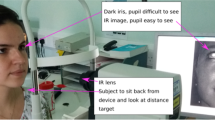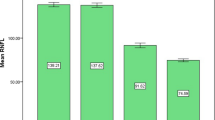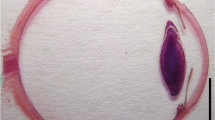Abstract
Background
A relative afferent pupillary defect (RAPD) is known to develop only when more than 25% of retinal ganglion cells are ablated in monkeys’ eyes. However, there was no prior study to estimate biometrically the degree of retinal nerve fiber layer (RNFL) thickness reduction leading to the development of RAPD in live human eyes. The purpose of this study was to examine the correlation between the amount of RNFL thickness reduction and the depth of a clinically detectable RAPD in patients with unilateral optic atrophy.
Methods
Enrolled were 20 patients with optic atrophy of various etiologies. We quantified RAPD by performing the swinging flashlight test with log-scaled neutral density filters placed over the unaffected eye. Average RNFL thickness was measured by OCT3000 with the average RNFL thickness program. Linear regression analysis was used in assessing the relationship between RAPD and the ratio of affected to unaffected average RNFL thickness.
Results
The mean of average RNFL thickness was 95.6±17.3 μm in the unaffected eyes and 50.7±19.3 μm in the affected eyes (P<0.001). Regression analysis between RAPD and the ratio of affected to unaffected average RNFL thickness revealed a correlation coefficient R2=0.48 (P=0.0007). The regression line intersected the y-axis at 0.77.
Conclusions
RAPD was not clinically detected until at least approximately 25% of the retinal nerve fibers were lost when compared with the unaffected eyes. Substantial retinal ganglion cell damage is required for the development of RAPD.

Similar content being viewed by others
References
Fujimoto JG, Hee MR, Huang D, Schuman JS, Puliafito CA, Swansom MS (2003) Principles of optical coherence tomography. In: Schuman JS, Puliafito CA, Fujimoto JG (eds) Optical coherence tomography of ocular diseases, 2nd edn. Slack, Thorofare, pp 3–19
Huang D, Swanson EA, Lin CP, Schuman JS, Stinson WG, Chang W, Hee MR, Flotte T, Gregory K, Puliafito CA, Fujimoto JG (1991) Optical coherence tomography. Science 254:1178–1181
Hwang JM, Kim C, Kim JY (2004) Relative afferent pupillary defect in patients with asymmetric cataracts. J Cataract Refract Surg 30:132–136
Jaffe GJ, Caprioli J (2004) Optical coherence tomography to detect and manage retinal disease and glaucoma. Am J Ophthalmol 137:156–169
Johnson LN, Hill RA, Bartholomew MJ (1988) Correlation of afferent pupillary defect with visual field loss on automated perimetry. Ophthalmology 95:1649–1655
Kanamori A, Nakamura M, Escano MF, Seya R, Maeda H, Negi A (2003) Evaluation of the glaucomatous damage on retinal nerve fiber layer thickness measured by optical coherence tomography. Am J Ophthalmol 135:513–520
Kanamori A, Nakamura M, Matsui N, Nagai A, Nakanishi Y, Kusuhara S, Yamada Y, Negi A (2004) Optical coherence tomography detects characteristic retinal nerve fiber layer thickness corresponding to band atrophy of the optic discs. Ophthalmology 111:2278–2283
Kardon RH, Haupert CL, Thomson HS (1993) The relationship between static perimetry and the relative afferent pupillary defect. Am J Ophthalmol 115:351–356
Kerrison JB, Buchanan K, Rosenberg ML, Clark R, Andreason K, Alfaro DV, Grossniklaus HE, Kerrigan-Baumrind LA, Kerrigan DF, Miller NR, Quigley HA (2001) Quantification of optic nerve axon loss associated with a relative afferent pupillary defect in the monkey. Arch Ophthalmol 119:1333–1341
Lagreze WDA, Kardon RH (1998) Correlation of relative afferent pupillary defect and estimated retinal ganglion cell loss. Graefes Arch Clin Exp Ophthalmol 236:401–404
Lam BL, Thompson HS (1990) A unilateral cataract produces a relative afferent pupillary defect in the contralateral eye. Ophthalmology 97:334–338
Levin PS, Newman SA, Quigley HA, Miller NR (1983) A clinicopathologic study of optic neuropathies associated with intracranial mass lesions with quantification of remaining axons. Am J Ophthalmol 95:295–306
Quigley HA, Miller NR, Green WR (1985) The pattern of optic nerve fiber loss in anterior ischemic optic neuropathy. Am J Ophthalmol 100:769–776
Tatsumi Y, Kanamori A, Kusuhara A, Nakanishi Y, Kusuhara S, Nakamura M (2005) Retinal nerve fiber layer thickness in optic tract syndrome. Jpn J Ophthalmol 49:294–296
Thompson HS, Corbett JJ, Cox TA (1981) How to measure the relative afferent pupillary defect. Surv Ophthalmol 26:39–42
Thomson HS, Montague P, Cox TA, Corbett JJ (1982) The relationship between visual acuity, pupillary defect, and visual field loss. Am J Ophthalmol 93:681–688
Author information
Authors and Affiliations
Corresponding author
Rights and permissions
About this article
Cite this article
Nakanishi, Y., Nakamura, M., Tatsumi, Y. et al. Quantification of retinal nerve fiber layer thickness reduction associated with a relative afferent pupillary defect. Graefe's Arch Clin Exp Ophthalmo 244, 1480–1484 (2006). https://doi.org/10.1007/s00417-006-0327-1
Received:
Revised:
Accepted:
Published:
Issue Date:
DOI: https://doi.org/10.1007/s00417-006-0327-1




